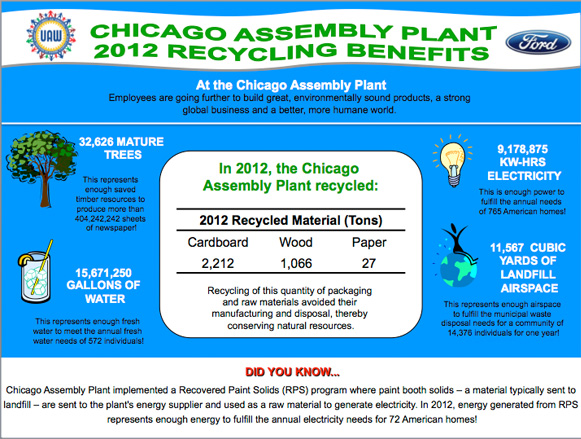Sustainability Report 2013/14
Climate Change and the Environment
Waste Management
Ford’s environmental goals include reducing the amount and toxicity of manufacturing-related wastes and ultimately eliminating the disposal of waste in landfills. Manufacturing byproducts include both hazardous and nonhazardous wastes. In 2013, we introduced a new plan to reduce waste sent to landfill by 40 percent on a per vehicle basis between 2011 and 2016 globally. We have already reduced global per vehicle waste to landfill by 40 percent from 2007 to 2011. In 2013, Ford facilities globally sent approximately 49,800 metric tons of waste to landfill, a reduction of 5.4 percent from 2012.
In 2013, Ford facilities globally generated approximately 43,000 metric tons of hazardous waste, which is comparable to our 2012 hazardous waste-generation levels, despite increased vehicle production. We reduced hazardous waste on a per vehicle basis by 7 percent compared to 2012 and by 27 percent over the last five years. Ford has chosen to target eliminating the landfill of hazardous waste first, because this provides the quickest and most cost-effective benefits to human health and the environment.
Ford’s five-year global waste-reduction plan details how the company will lessen its environmental impact

5 Key Actions
Invest
- Continue investing in new technologies that minimize waste
Standardize
- Standardize how waste is tracked and sorted at each point
Identify
- Identify the five largest volume sources of waste-to-landfill at each facility
Partner
- Partner with suppliers to increase use of eco-friendly packaging
Enable
- Enable local plants to affect waste management change
Current waste mix

- Wastewater sludge
- Recovered paint solids
- Packaging waste
- Used oils and waste solvent
- Grinding swarf (metallic particles, abrasives and oils)
- Other wastes
Fun fact
The Oakville Assembly Plant in Canada is the first Ford North American vehicle assembly plant to achieve zero waste to landfill status. Joining Windsor Engine Plant and Essex Engine Plant, now all Ford manufacturing operations in Canada send zero waste to landfill.

Progress
Ford cut the amount of waste to landfill generated per vehicle produced globally from 33 pounds in 2009 to 18 pounds in 2013.
Goal
By 2016, Ford will reduce pounds of waste to landfill generated per vehicle globally to 15 pounds.
We will reach our new waste-reduction goal and continue to build on our past success in waste reduction through many programs, including:
- Identifying the five largest-volume waste to landfill streams at each plant, developing plans to reduce each and track progress
- Minimizing waste by leveraging the Ford production system – a continuously improving, flexible and disciplined common global production system that encompasses a set of principles and processes to drive lean manufacturing
- Improving waste-sorting procedures to make recycling and reuse easier
- Investing in new technologies that minimize waste, such as dry-machining
- Expanding programs that deal with managing specific kinds of waste, such as metallic particles from the grinding process and paint sludge
The following Ford facilities have achieved Ford’s stringent definition of zero waste to landfill1:
- JMC Xiaolan
- Chennai Assembly
- Cologne Assembly
- Saarlouis Assembly
- Essex Engine
- Van Dyke Transmission
- Cologne Engine
- Cologne Die Cast
- Cologne Cotarko Forging
- Chennai Engine
- Windsor Engine
- Ford Thailand Manufacturing
- Bordeaux Transmission
- Engine Manufacturing Development Operations/Beech Daly Technical Center
- Michigan Proving Grounds
- Rawsonville
- Oakville Assembly
We are also improving the way we communicate our waste reduction success to employees as part of an effort to engage employees in further waste-reduction improvements. We are reporting not just waste-reduction and recycling totals, but how these numbers translate into more meaningful impacts like number of trees saved. An example of one of these communications is provided below.

Some other successes of our waste-reduction efforts in 2013 include the following:
- We continued to implement our minimum quantity lubricant (MQL) machining process (also called near-dry machining) that reduces waste by more than 80 percent for each engine we produce, also saving oil and water. We have now implemented this process at six plants in North America, Asia, and Europe. For more information on the water benefits of MQL, please see the Water: Investing in New Technologies section.
- Our Chennai Vehicle Assembly Plant improved the practices at their hazardous waste storage yard. By using Ford Production System principles to standardize the process, the plant was able to minimize environmental and safety hazards, meanwhile achieving economic benefits from proper waste segregation.
- We initiated efforts to recycle grinding swarf at U.S. and Canadian facilities. This pilot program has the potential to eliminate of 3 million pounds of waste sent to landfill each year.
- Ford of Mexico recycled 33,602 tonnes of aluminum, cardboard, paper, scrap metal, plastics, wood and glass.
- Cuautitlán Stamping and Assembly Plant recently implemented an innovative recycling project aimed at keeping car parts containers out of landfills by restoring them for delivery to various schools where they will be used as trash cans.
- Kentucky Truck Plant started to recycle bailed plastic, Tyvec-coated paper bails and five-gallon pails that were going to landfill. Now 14,500 pounds previously sent to landfill is now being captured for reclamation.
- Sterling Axle Plant began sending one third of their lapping compound, approximately 70,000 kg/year, for reblending in order to make new product for use at the plant instead of landfilling the material.
- Ford Argentina donated more than 4 tons of nonreturnable PET bottles to “Fundación Banco de Bosques” (Forest Bank Foundation) that aims to save native forests which are in danger of extinction.
- Kocaeli Assembly Plant is keeping 500 tonnes/year of municipal waste out of landfills by using it as an alternate fuel in cement kilns.
- Waste to landfill is defined as all production waste sent to landfill, excluding episodic waste, and construction and demolition debris. Scrap metal is not included in waste to landfill.
© 2014 Ford Motor Company

